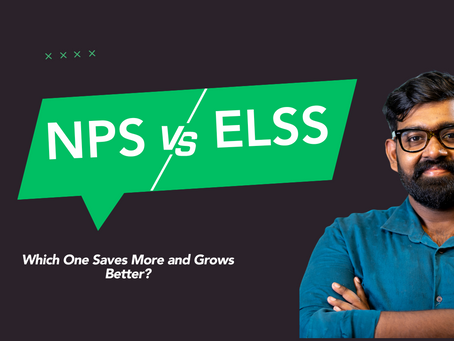top of page
Search


Open Ended Fund vs Closed Ended Fund: The Structural Edge Investors Must Understand
Two mutual funds can hold similar assets yet deliver very different investor experiences. This piece explains how the open-ended or closed-ended structure behind a fund shapes liquidity, strategy, and long-term outcomes.

Bhanu Kiran
18 hours ago6 min read


The Strategic Role of Liquid Mutual Funds in Cash Management
Short-term money decisions often go unnoticed until liquidity becomes a constraint. This blog examines how Liquid Mutual Funds fit into cash management, offering structure and intent where idle funds usually drift without purpose.

Bhanu Kiran
6 days ago4 min read


Mid-Cap Funds Performance: A Rolling vs Point-to-Point Return Study
Rolling and point-to-point returns can tell very different stories for mid-cap mutual funds. Comparing the two highlights which metric better reflects consistent performance, volatility, and the real investor experience across market cycles.
Ayesha Bee
6 days ago3 min read


NRI Mutual Fund Investments: Accounts, Documentation, and Tax Rules
FEMA rules, account types, KYC, and taxation shape the way NRIs mutual fund investments operate. Understanding these conditions clarifies how eligibility, compliance, and repatriation limits work before any capital is committed.

Bhanu Kiran
Oct 36 min read


Thematic Mutual Funds: Definition, Key Features, and Investor Suitability in India
Thematic Mutual Funds allocate capital around structural ideas rather than single sectors. This approach raises distinct questions on construction, regulation, and taxation that investors must understand before treating them as part of a long-term portfolio strategy.

Bhanu Kiran
Aug 235 min read


Dividend vs Growth Option Mutual Fund Determines Post-Tax Wealth Outcomes
The distinction between dividend vs growth option mutual fund lies in how returns are treated, influencing taxation, NAV behavior, and long-term efficiency. This analysis sets out the mechanics and trade-offs, highlighting factors that materially alter investment outcomes beyond the portfolio’s performance itself.

Bhanu Kiran
Aug 215 min read


SIP Adjustments in Volatility Require Precision Beyond Cost Averaging
This blog examines SIP adjustments in volatility through market-cycle dynamics, showing how measured contribution changes and allocation reviews can align portfolios with shifting risk conditions while preserving the structural benefits of systematic investing.

Bhanu Kiran
Aug 184 min read


Systematic Withdrawal Plan (SWP): How to Convert Investments into Reliable Income
Most investors spend years picking the right mutual fund but give little thought to how and when to withdraw. This blog unpacks how a
Systematic Withdrawal Plan (SWP) works, who it's suited for, and how the right withdrawal strategy can preserve wealth, reduce taxes, and create sustainable income — especially when every percentage point counts.

Bhanu Kiran
Aug 64 min read


ETF vs Index Funds: What's the Difference? Performance Analysis and Tracking Error
ETFs vs Index Funds: Which One Works Better for You?
Both aim to track the same indices—but differ in how they operate, what they cost, and how closely they match returns.
We analysed real 1-year tracking error and 3-year CAGR data across 80+ funds to see how they stack up.
If you’re confused between the two, this post breaks it down simply—with data to back it.
👉 Give it a read before you invest.
Ayesha Bee
Jul 246 min read


SIP Investment Tax Benefits: How to Save Income Tax with Mutual Funds
SIPs can help you save tax—but only if you choose the right type. This blog explains how ELSS mutual funds work under Section 80C, which plans qualify, and the common mistakes that silently cost investors their tax benefits.

Bhanu Kiran
Jul 214 min read


Capital Gains Tax on Mutual Funds Explained: Equity vs Debt, LTCG vs STCG
Capital gains tax on mutual funds isn’t as straightforward as it seems. The rules differ by fund type, holding period, and even the year of investment.
This blog breaks down short-term and long-term capital gains treatment, recent rule changes, and practical strategies to optimize post-tax returns.

Bhanu Kiran
Jul 166 min read


NPS vs ELSS: Which is Better for Tax Saving and Long-Term Growth?
ELSS and NPS both offer tax-saving benefits, but they serve different purposes. ELSS is equity-focused with a short lock-in, ideal for wealth creation. NPS is structured for retirement, with controlled equity exposure and longer commitment.
This blog helps you understand how they compare on returns, risk, tax treatment, and liquidity, so you can make an informed choice aligned with your financial goals.

Bhanu Kiran
Jul 154 min read


Equity Linked Savings Scheme (ELSS): Understanding Benefits and Risks
ELSS is a tax-saving mutual fund that invests in equities and comes with a 3-year lock-in. This blog breaks down how ELSS works, its risks, benefits, and how to invest smartly, whether through SIP or lump sum. Ideal for long-term investors looking to save tax under Section 80C while building wealth.

Bhanu Kiran
Jul 144 min read


Top Mid-Cap Mutual Funds in India (2025): Performance, Risk, and Cost Compared
Mid-cap mutual funds sit at the intersection of growth and risk. T
his analysis compares 20 long-standing schemes on returns, risk-adjusted performance, costs, and consistency highlighting which funds truly stand out over 3, 5, and 10 years.
Ayesha Bee
Jul 125 min read


Direct vs Regular Mutual Funds: 10-Year Cost-Adjusted Performance Analysis
Over a 10-year period, the difference between direct and regular mutual funds can significantly impact your returns.
While both invest in the same portfolio, regular plans charge higher fees due to distributor commissions.
This blog analyzes cost-adjusted performance across equity, debt, and hybrid categories, showing how even small fee differences can compound into meaningful return gaps.
A must-read for anyone looking to make smarter investment choices.
Ayesha Bee
Jul 15 min read


Analyzing the Performance of Sectoral Mutual Funds for AI and Technology in India
Technology Mutual Funds in India have gained momentum with the rise of AI and digital innovation. This blog breaks down the performance of sectoral funds focused on tech and AI, helping investors understand where the real potential and risks lie.
Ayesha Bee
Jun 206 min read


Advantages and Disadvantages of Mutual Funds in India: A Clear Guide for Investors
This blog explores their key advantages of mutual funds, like diversification, expert management, and tax-saving options, while also addressing common drawbacks such as costs, volatility, and limited control.
A complete breakdown to help you decide if mutual funds align with your financial goals.

Bhanu Kiran
Jun 45 min read


SIP vs. Lump Sum: Which is the Best Way to Invest in Mutual Funds in India?
SIP vs Lump Sum isn’t a battle of better or worse. It’s a question of fit.
Whether you earn monthly or receive money in chunks, how you invest should match how you earn, how you handle risk, and how the markets behave. This blog breaks down both strategies, their advantages, and when to choose one over the other.

Bhanu Kiran
May 174 min read


Rupee Cost Averaging: How It Works and Why It Matters for Long-Term Investors
Rupee Cost Averaging is a simple yet powerful investing strategy that helps reduce your average cost per unit by investing consistently, no matter where the market is headed.
In this blog, we break down what rupee cost averaging means, how it works through SIPs, its benefits and limitations, and how it performs across different market scenarios.

Bhanu Kiran
May 166 min read


Types of Index Funds in India: How They Differ and What to Consider Before Investing
Not all index funds are created equal. From Nifty 50 and Sensex funds to midcap, smallcap, sectoral, and international indices, each type serves a different purpose in your portfolio. This blog breaks down the major types of index funds available in India, explains how they differ in composition and risk, and helps you understand how to match them with your financial goals and investment horizon.
Ayesha Bee
May 66 min read
bottom of page



